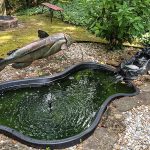Closing an above ground swimming pool for winter is essential to protect it from damage caused by freezing temperatures and harsh weather conditions. Properly winterizing your pool will help prevent costly repairs and ensure that it’s ready for use when the warmer months return. In this comprehensive guide, we’ll cover everything you need to know about closing an above ground swimming pool for winter, from the necessary supplies and equipment to step-by-step instructions for preparing your pool for the off-season.
## Importance of Winterizing Your Above Ground Swimming Pool
Winterizing your above ground swimming pool is crucial for maintaining its structural integrity and preserving the water quality. Without proper winterization, your pool is susceptible to damage from freezing and thawing cycles, as well as the growth of algae and bacteria. Additionally, neglecting to winterize your pool can result in costly repairs and a more challenging reopening process when spring arrives. By taking the time to close your above ground pool correctly, you can avoid these potential issues and ensure that it remains in excellent condition for years to come.
## Supplies and Equipment Needed for Winterizing Your Above Ground Swimming Pool
Before you begin the winterization process, it’s essential to gather all the necessary supplies and equipment. Here’s a list of items you’ll need to effectively close your above ground swimming pool for winter:
– Winter cover or tarp
– Pool chemicals (chlorine, algaecide, shock treatment)
– Pool winterizing kit
– Pool cover air pillow
– Pool cover pump
– Winterizing plugs or gizzmos
– Skimmer plug
– Pool brush and vacuum
– Telescopic pole
– Pool cover clips or cable and winch
– Submersible pump (if needed)
– Air compressor (if needed for blowing out lines)
By having these supplies and equipment on hand, you’ll be well-prepared to complete the winterization process with ease and efficiency.
## Step-by-Step Guide to Closing Your Above Ground Swimming Pool for Winter
### Step 1: Clean and Balance the Water
Start by thoroughly cleaning your pool to remove any debris, leaves, and dirt. Use a pool brush and vacuum to scrub the walls and floor, ensuring that the water is clear and free of any contaminants. Next, test the water chemistry and adjust the pH, alkalinity, and sanitizer levels as needed to achieve proper balance. This will help prevent the buildup of algae and bacteria during the winter months.
### Step 2: Add Winterizing Chemicals
Once the water is clean and balanced, it’s time to add winterizing chemicals to prepare the pool for the off-season. A winterizing kit typically includes a combination of algaecide, shock treatment, and other chemicals designed to inhibit the growth of algae and bacteria while the pool is closed. Follow the manufacturer’s instructions for the proper application of these chemicals, ensuring that they are thoroughly distributed throughout the water.
### Step 3: Install Winter Cover and Air Pillow
After adding the winterizing chemicals, it’s important to install a durable winter cover or tarp to protect the pool from debris and harsh weather. Before placing the cover over the pool, inflate a pool cover air pillow and position it in the center of the water. The air pillow helps to support the cover and prevent water from accumulating in the center, reducing the risk of damage to the pool walls and liner.
### Step 4: Secure the Cover and Remove Excess Water
Once the winter cover is in place, secure it using pool cover clips or a cable and winch system to ensure a tight and secure fit. This will prevent the cover from being dislodged by strong winds or heavy snow. Additionally, use a pool cover pump to remove any excess water that accumulates on top of the cover, as this can cause stress and damage to the cover and pool structure.
### Step 5: Protect the Plumbing and Equipment
To prevent damage to the pool’s plumbing and equipment during freezing temperatures, it’s essential to take measures to protect these components. Install winterizing plugs or gizzmos in the skimmer and return lines to prevent water from entering and freezing inside the pipes. Additionally, use a skimmer plug to seal off the skimmer opening and prevent damage from ice expansion. If needed, use an air compressor to blow out the lines and remove any remaining water.
### Step 6: Store Pool Accessories and Equipment
Before completing the winterization process, take the time to properly store pool accessories and equipment to prevent damage and deterioration during the off-season. Remove and clean the pool ladder, toys, and other items, and store them in a dry, sheltered location. Additionally, disconnect and drain the pump, filter, and any other equipment, storing them in a protected area to safeguard them from the elements.
### Step 7: Regular Maintenance and Inspection
Throughout the winter months, it’s important to perform regular maintenance and inspection of your closed above ground swimming pool. Periodically check the cover to ensure it remains secure and free of debris, and use a pool cover pump to remove any accumulated water. Additionally, monitor the water level and address any issues that may arise to prevent damage to the pool structure and cover.
## Conclusion
Properly closing your above ground swimming pool for winter is a critical task that should not be overlooked. By following the step-by-step guide outlined in this article and using the necessary supplies and equipment, you can ensure that your pool remains in excellent condition throughout the off-season. Winterizing your pool will not only protect it from damage but also make the reopening process easier and more enjoyable when the warm weather returns. With the right approach and attention to detail, you can confidently prepare your above ground swimming pool for winter, knowing that it will be ready for use when the temperatures rise once again.




